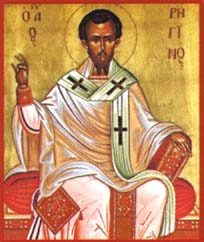Difference between revisions of "Reginos of Skopelos"
m |
m (add info) |
||
| Line 1: | Line 1: | ||
[[Image:St-reginos.jpg|right|thumb|Hieromartyr St. Reginos]] | [[Image:St-reginos.jpg|right|thumb|Hieromartyr St. Reginos]] | ||
| − | Hieromartyr Saint ''' | + | Hieromartyr Saint '''Réginos''' (Greek: 'Aγιος Ρηγίνος) is the patron saint of the island of [[w:Skopelos|Skopelos]], Greece. He was a [[bishop]] who was tortured for the faith and finally beheaded in 362 AD under the reign of the Emperor [[Julian the Apostate]], along with forty others. |
| + | |||
| + | Saint Réginos was born in [[w:Livadeia|Livadeia]] in central Greece, in the late third century to Christian parents, who instilled in him the love of virtue and zeal for truth. When the bishop of Skopelos passed away, Saint Réginos was acclaimed as the new bishop by all of the people. As the [[Arianism|Arian heresy]] continued to rage after the [[First Ecumenical Council|Council of Nicaea]] (325), a new [[w:Council of Sardica|council was called at Sardica]] (Sofia, Bulgaria) in 343, during which St. Réginos distinguished himself by his ability to refute the heretics. | ||
| − | + | His is commemorated on [[February 25]], which is a local holiday on the island. At the Monastery of Saint Réginos, which houses the relics of the saint, thousands of faithful gather each year on February 25 from the surrounding islands of Skiathos and Alonissos as well as from the coastal port city of Volos, to pay hommage to the martyr. The saint has shown his love for his flock by performing several miracles of healing according to the locals, several of which have named their children after him (''Réginos'' or ''Regina''). | |
==Sources== | ==Sources== | ||
* [[w:Reginos|Reginos]] at Wikipedia. | * [[w:Reginos|Reginos]] at Wikipedia. | ||
* [http://calendrier.egliseorthodoxe.com/sts/stsfevrier/fev25.html Le 25 février, mémoire du Saint Hiéromartyr REGINOS, Evêque de SKOPELOS, mort par le glaive] | * [http://calendrier.egliseorthodoxe.com/sts/stsfevrier/fev25.html Le 25 février, mémoire du Saint Hiéromartyr REGINOS, Evêque de SKOPELOS, mort par le glaive] | ||
| − | + | '''Greek Wikipedia''' | |
| + | * [http://el.wikipedia.org/wiki/%CE%86%CE%B3%CE%B9%CE%BF%CF%82_%CE%A1%CE%B7%CE%B3%CE%AF%CE%BD%CE%BF%CF%82 Άγιος Ρηγίνος] | ||
[[Category:Bishops]] | [[Category:Bishops]] | ||
Revision as of 13:14, April 9, 2011
Hieromartyr Saint Réginos (Greek: 'Aγιος Ρηγίνος) is the patron saint of the island of Skopelos, Greece. He was a bishop who was tortured for the faith and finally beheaded in 362 AD under the reign of the Emperor Julian the Apostate, along with forty others.
Saint Réginos was born in Livadeia in central Greece, in the late third century to Christian parents, who instilled in him the love of virtue and zeal for truth. When the bishop of Skopelos passed away, Saint Réginos was acclaimed as the new bishop by all of the people. As the Arian heresy continued to rage after the Council of Nicaea (325), a new council was called at Sardica (Sofia, Bulgaria) in 343, during which St. Réginos distinguished himself by his ability to refute the heretics.
His is commemorated on February 25, which is a local holiday on the island. At the Monastery of Saint Réginos, which houses the relics of the saint, thousands of faithful gather each year on February 25 from the surrounding islands of Skiathos and Alonissos as well as from the coastal port city of Volos, to pay hommage to the martyr. The saint has shown his love for his flock by performing several miracles of healing according to the locals, several of which have named their children after him (Réginos or Regina).
Sources
- Reginos at Wikipedia.
- Le 25 février, mémoire du Saint Hiéromartyr REGINOS, Evêque de SKOPELOS, mort par le glaive
Greek Wikipedia
Categories > Church History
Categories > Church History
Categories > Church History
Categories > Church History
Categories > Church History
Categories > Liturgics > Feasts
Categories > Liturgics > Feasts
Categories > Liturgics > Feasts
Categories > Liturgics > Feasts
Categories > Liturgics > Feasts
Categories > People > Clergy > Bishops
Categories > People > Clergy > Bishops > Bishops by century > 4th-century bishops
Categories > People > Saints
Categories > People > Saints > Byzantine Saints
Categories > People > Saints > Greek Saints
Categories > People > Saints > Martyrs
Categories > People > Saints > Saints by century > 4th-century saints
